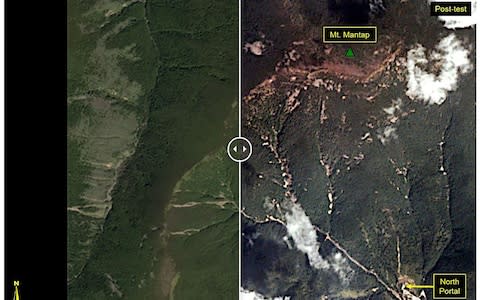North Korea nuclear programme rocked by 'collapse' of test site

Part of North Korea’s main nuclear weapons testing site may not be usable for further trials following a collapse in the mountain above it, according to a report by a team of Chinese geologists.
According to researchers at the University of Science and Technology (USTC) a collapse at Mount Mantapsan, above northwest North Korea’s Punggye-ri nuclear test site, occurred after the country’s latest nuclear tests in September 2017.
A second Chinese study, including input from researchers from the China Earthquake Administration, also said that the collapse was due to the September aftershock.
The findings come ahead of historic talks between the South and North on Friday, where the leaders are set to discuss denuclearisation on the peninsula.
The USTC study led to speculation the collapse may have informed North Korean leader Kim Jong-un’s decision on Saturday to suspend the country’s nuclear testing.
When delivered, the announcement was widely perceived to have been an overture ahead of Friday’s scheduled talks with Moon Jae-in, the South Korean President, and Kim. Pending the outcome of Friday's meeting, Kim is also due to meet with US President Donald Trump in late May or June, with Mr Trump’s stated goal for Kim to agree to scrapping his nuclear weapons programme.

The USTC report, which will be published in US science journal Geophysical Research Letters, said: “The occurrence of the collapse should deem the underground infrastructure beneath mountain Mantap not be used for any future nuclear tests.”
Last September North Korea conducted what it claimed was a test of a thermonuclear bomb at Punggye-ri, which has hosted five of the country’s six tests, with the first taking place in 2006. Four earthquakes in the area were reported following the bomb test, the yield of which was estimated to be equivalent to over 100 kilotons of TNT: North Korea’s biggest yet.
USTC scientists said it was important to “continue to monitor any leakage of radioactive materials that may have been caused by the collapse”. Chinese authorities have conducted tests for radiation near China’s border with North Korea, which is less than 100km from Punggye-ri, and have not reported any radiation risk.
Jeffrey Lewis, director East Asia Nonproliferation Program at the Middlebury Institute of International Studies, said that reports about links between Kim suspending nuclear testing and the state of the test site were premature. Despite the Chinese report’s claim, he said that North Korea was still capable of further nuclear tests, on other sites in the country.
Referring to the collapse at the Punggye-ri site he said: “This does not mean the tunnel complex below the mountain is ruined. North Korea shouldn't use the exact same cavity again, which has some implications for decoupling scenarios, but new branches off the main tunnel should be fine. Kim can keep testing there if he wants.”
He added: “At most, North Korea might shift big tests to neighbouring mountains. Kim has agreed to stop nuclear testing because of the summit(s), not because his nuclear test mountain collapsed.”
Kim and Mr Moon are set to meet on Friday morning in a joint security area between North and South Korea.

 Yahoo News
Yahoo News 
